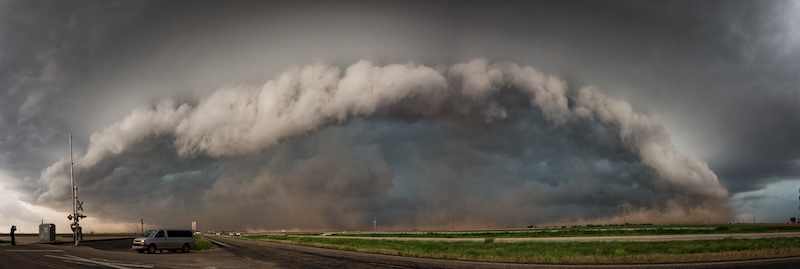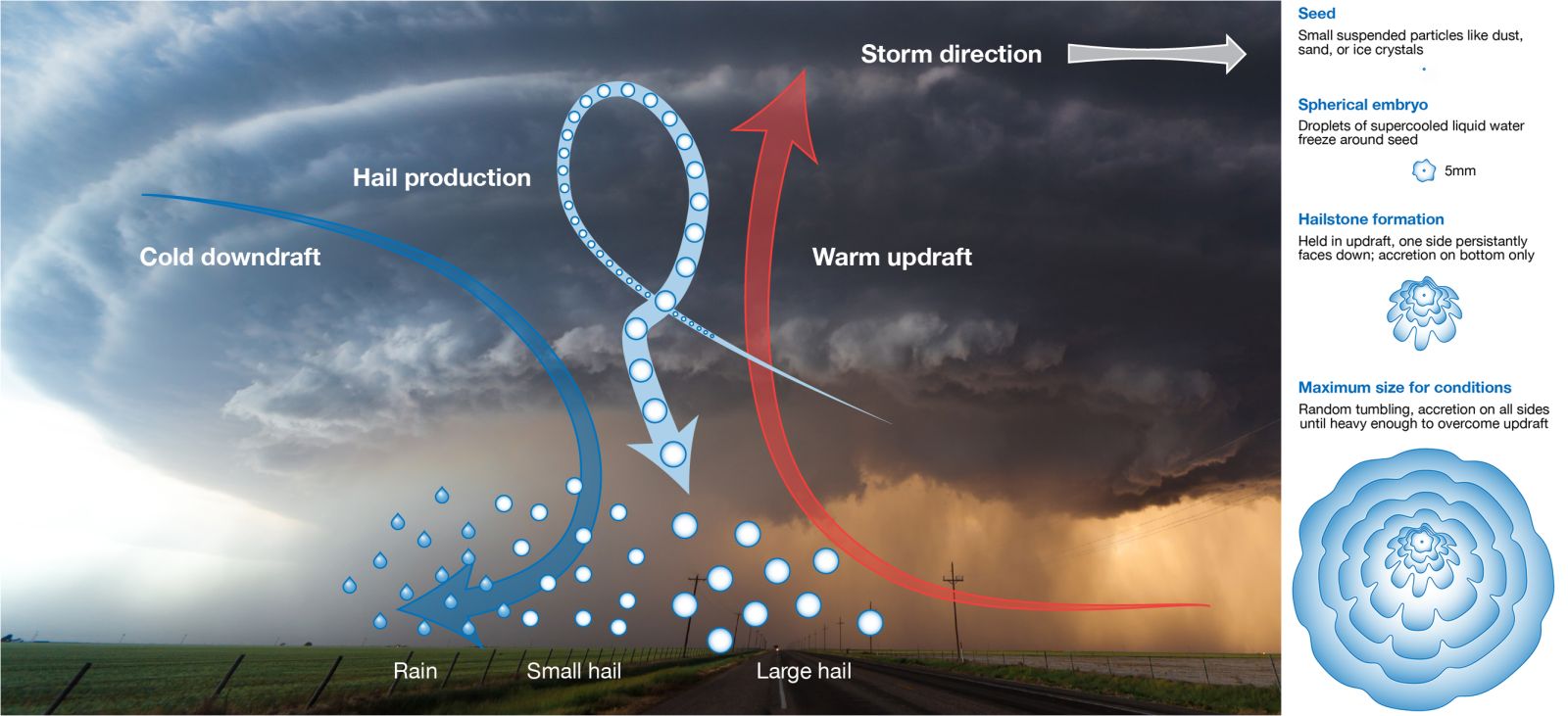Hail Formation in Severe Convective Storms
The National Oceanic and Atmospheric Administration (NOAA) estimates that in 2024 alone, the United States experienced 27 weather- and climate-related billion-dollar disaster events, with losses totaling $182.7 billion. Severe convective storms — a category that includes hazards such as high wind, extreme hail, and tornadoes — were responsible for 17 of those 27 events, resulting in an estimated $46.8 billion in combined damages.
Given the increasing frequency and severity of damaging convective storm events, it is important for clean energy project stakeholders to understand not only how hail forms but also how climate scientists predict hailstorms to change in the coming decades.

© Robert / stock.adobe.com
Hailstone formation and growth
The World Meteorological Organization defines a hailstone as any particle of ice larger than 5 mm in diameter generated within a convective thunderstorm. Generally, hail-producing convective storms develop when some mechanism — perhaps a large-scale meteorological phenomenon such as a weather front or even a physical geographic feature like a mountain range — forces large volumes of air to move vertically upward into an unstable layer of the atmosphere.
In the meteorological context, unstable refers to a state where the relative temperature of a pocket of air (typically referred to as an air parcel) is warmer and thus less dense than its surroundings. This concept of atmospheric instability is fundamental to severe thunderstorm generation, as it helps drive the hail generation process by supplying the necessary moisture content to the upper levels of the troposphere.
When these unstable conditions occur, the warm air parcel ascends on its own without the need for additional forcing from large-scale features. Conceptually, the air pocket behaves much like a hot-air balloon, which will rise freely after a propane burner heats the interior air and increases its buoyancy.

As parcels of warm air ascend, water vapor cools and condenses into the small water droplets that contribute to cloud formation. Even after the parcel reaches a subfreezing layer characterized by temperatures in the 0°C to -20°C range, some water droplets exist in supercooled liquid form, a key ingredient for hailstone creation and growth.
As this supercooled liquid water chaotically collides with ice-nucleating particles — which are small particles of sand, dust, or ice suspended in the atmosphere — it freezes, and the hailstones grow larger. This growth process can take various forms, significantly impacting the eventual density and physical characteristics of the resulting hailstones.
Dry growth occurs when temperatures are well below freezing and any remaining supercooled water droplets freeze immediately upon contact with a growing hail embryo, which traps tiny bubbles of air within the stone, leading to cloudy-looking, lower-density hail. Alternatively, wet growth occurs when temperatures are just below freezing, and water droplets that collide with a hail embryo first spread over its surface and freeze slowly, allowing air bubbles to escape, which creates a very transparent and dense layer of ice around the hailstone.
These growth processes are directly linked to hail density, meaning they are critical for understanding the ballistic-impact damage potential associated with falling hailstones.
Modeling hail in a future climate
Meteorologists have extensively investigated how the size of hail and the frequency of hail events are influenced by potential changes in the key factors that contribute to hail formation and growth during severe thunderstorms. These factors include variations in total moisture content and the microscale properties of cloud physics.
Given that every 1°C of anthropogenic warming is expected to coincide with a 7 percent increase in atmospheric water vapor content, convective instability is projected to increase over much of the United States by the end of the century. Moreover, higher moisture content would also add to the supercooled water available to a storm in the primary hail growth region, potentially leading to larger, denser hailstones.
It is likely that these effects will be counteracted, at least slightly, by deeper layers of warm air near the Earth’s surface, increasing the degree to which hail melts as it falls to the ground. However, larger hailstones have a greater mass and fall at a faster rate than smaller ones. Therefore, larger hailstones would be less impacted by this potential increase in melting.
An increase in moisture content not only provides potential for greater availability of supercooled water but also allows for greater energy release through the condensation process. More energy release would further the positive feedback loop that is atmospheric instability and add to the potential for more frequent and stronger severe thunderstorms.
Transitioning from understanding how these atmospheric ingredients may change in a future climate into actual predictions of hail frequency and severity presents a problem: If we only model the important hail creation variables, we are only predicting environments favorable for hailstorms and not hail occurrence directly.
To get around this issue, some climate scientists have begun predicting the future landscape of severe weather using a tactic known as dynamical downscaling, which utilizes the output from a global climate model as the input to short-term regional weather models that predict our weather patterns on a day-to-day basis. In this way, climate modelers can allow storms to initiate based on a set of predicted starting conditions, rather than relying solely on an ingredients-based modeling approach.

Such studies predict that by the end of the century, the number of >20 mm summertime hail days in the western United States may increase by up to 6 days per month but decrease by 3 to 5 days per month east of the Rockies, where hail risk is generally greatest. Increases in days with significantly severe hail events (>50 mm) are expected to increase over the same time scale, potentially by 2 days per month in the Central Plains states.
Changes to severe convective storm meteorology are not an insurmountable barrier to clean energy project development activities. By continuing to innovate, industry stakeholders can develop creative solutions that mitigate severe weather risk. Moreover, by better understanding the complex meteorological systems that generate these events, we can pave the path to a more resilient future where we are better prepared to deal with severe convective storms and extreme hail events.
Denis Weaver is the staff meteorologist for VDE Americas, a technical advisory firm that has supported the financing of over $15 billion in clean energy assets and is a leading expert in hail risk intelligence and loss prevention.
VDE Americas | www.vde-americas.com
Author: Denis Weaver
Volume: 2025 July/August











.png?r=4915)
